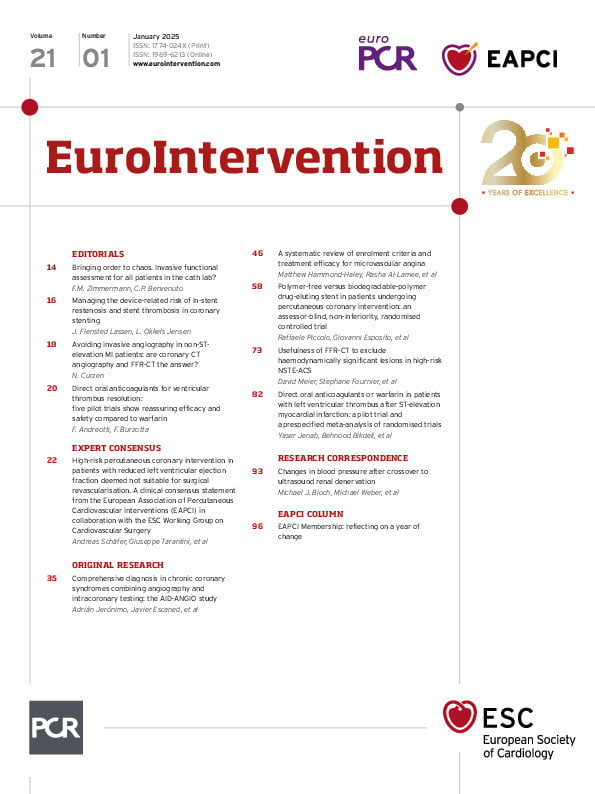Cory:
Unlock Your AI Assistant Now!
Over the past decades, the toolbox of the interventional cardiologist has expanded significantly to assess the heterogeneous nature of chronic coronary syndrome (CCS). Beyond epicardial disease, several subtypes of angina with non-obstructive coronary artery disease (ANOCA) have been identified, including microcirculatory and vasomotor dysfunction12. While these advancements are essential for clinical research, they add complexity to daily practice. The growing array of diagnostic tools raises an important question: how do we decide which tool to use and when? For example, selecting patients who will benefit most from microcirculatory assessment is a challenge that varies widely across hospitals, further complicating the adoption of standardised protocols.
With this background, we read with great interest the study by Jerónimo et al in this issue of EuroIntervention3. The authors propose a comprehensive ‘one-stop shop’ algorithm for evaluating a broad population with chest pain in the cath lab3. They enrolled 317 consecutive patients with chronic coronary syndrome referred for invasive coronary angiography and applied a hierarchical algorithm for invasive functional assessment. Their hierarchical protocol first identified >90% stenoses on the angiogram and performed an invasive evaluation of <90% lesions using fractional flow reserve (FFR) or resting full-cycle ratio (RFR). For patients without significant epicardial disease, functional testing was performed to evaluate microcirculatory and vasomotor disorders, consistent with recent ESC guidelines and studies like CorMicA12. This approach identified a potential cause of myocardial ischaemia in 84% of patients – a 2.6-fold increase compared with the angiogram alone (32%) – and led to modification of the original treatment plan in 59.9% of cases. Importantly, the protocol appeared safe, consistent with prior studies that included acetylcholine testing24. The authors are to be commended for demonstrating that such a streamlined and comprehensive diagnostic protocol is feasible in clinical practice. Additionally, the study confirms the high prevalence of ANOCA in a broad population.
This broad application, however, raises important questions. An abnormal finding does not necessarily indicate that the patient’s symptoms originate from the identified “abnormality”. For example, while a low coronary flow reserve (CFR) may reflect microvascular dysfunction, it may result from high resting flow, which can be caused by a variety of non-cardiac factors like anxiety. Similarly, an elevated index of microcirculatory resistance (IMR) can also be caused by other factors, such as a small myocardial territory. Labelling patients with a “disease” based on such findings may lead to unnecessary anxiety and the perception of chronic illness. This psychological burden risks undermining quality of life and prompting unnecessary follow-ups or interventions. For example, in the FAME 2 trial, only 10-15% of patients without significant epicardial disease reported significant chest pain in the months following angiography5. Comprehensive functional testing focused on patients with persistent symptoms may help mitigate these potential downsides.
In the present study, bolus thermodilution was used to calculate CFR and IMR. Continuous thermodilution has shown higher reproducibility and accuracy compared with bolus thermodilution6. In addition, CFR is influenced by epicardial disease. Microvascular resistance reserve (MRR) provides a more precise measure of the vasodilatory capacity of the microcirculation, independent of epicardial disease7. Incorporating these advanced techniques, as ongoing registries like NL-CFT (ClinicalTrials.gov: NCT06083155) and Euro-CRAFT (NCT05805462) aim to do, could enhance diagnostic precision and expand our understanding of ANOCA.
In conclusion, the authors are to be congratulated for their valuable contribution to understanding the full spectrum of angina in daily practice. Their findings pave the way for integrating comprehensive diagnostic protocols and highlight opportunities to enhance these approaches further. We eagerly anticipate the results of ongoing studies that will shape future diagnostic strategies and expand therapeutic options for patients with angina.
Conflict of interest statement
F. Zimmermann and C. Pollio Benvenuto have no conflicts of interest to declare.

